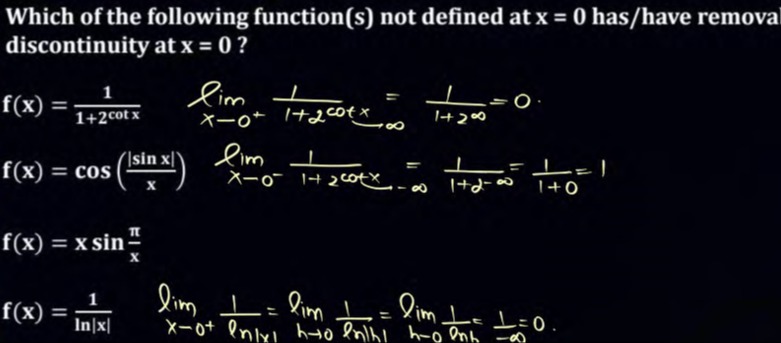Question
Question: Which of the following function(s) not defined at $x = 0$ has/have removal discontinuity at $x = 0$ ...
Which of the following function(s) not defined at x=0 has/have removal discontinuity at x=0 ?

A
f(x)=1+2cotx1
B
f(x)=cos(x∣sinx∣)
C
f(x)=xsinxπ
D
f(x)=ln∣x∣1
Answer
f(x) = cos(x∣sinx∣), f(x) = xsinxπ, f(x) = ln∣x∣1
Explanation
Solution
A function f(x) has a removable discontinuity at x=a if limx→af(x) exists and is finite, but is not equal to f(a) (or f(a) is undefined). Since the problem states the functions are not defined at x=0, we only need to check if the limit limx→0f(x) exists and is finite. This requires the left-hand limit (LHL) and the right-hand limit (RHL) at x=0 to be equal and finite.
-
f(x)=1+2cotx1
- LHL: As x→0−, cotx→−∞. limx→0−f(x)=1+2−∞1=1+01=1.
- RHL: As x→0+, cotx→+∞. limx→0+f(x)=1+2∞1=1+∞1=0.
- LHL = RHL. This is a non-removable discontinuity.
-
f(x)=cos(x∣sinx∣)
- LHL: As x→0−, x∣sinx∣=x−sinx→−1. limx→0−f(x)=cos(−1)=cos(1).
- RHL: As x→0+, x∣sinx∣=xsinx→1. limx→0+f(x)=cos(1).
- LHL = RHL = cos(1). The limit exists and is finite. This is a removable discontinuity.
-
f(x)=xsinxπ
- LHL: As x→0−, x→0 and sinxπ is bounded between -1 and 1. By the Squeeze Theorem, limx→0−xsinxπ=0.
- RHL: As x→0+, x→0 and sinxπ is bounded between -1 and 1. By the Squeeze Theorem, limx→0+xsinxπ=0.
- LHL = RHL = 0. The limit exists and is finite. This is a removable discontinuity.
-
f(x)=ln∣x∣1
- LHL: As x→0−, ∣x∣→0+, so ln∣x∣→−∞. limx→0−f(x)=−∞1=0.
- RHL: As x→0+, ∣x∣→0+, so ln∣x∣→−∞. limx→0+f(x)=−∞1=0.
- LHL = RHL = 0. The limit exists and is finite. This is a removable discontinuity.
The functions with removable discontinuities at x=0 are cos(x∣sinx∣), xsinxπ, and ln∣x∣1.
